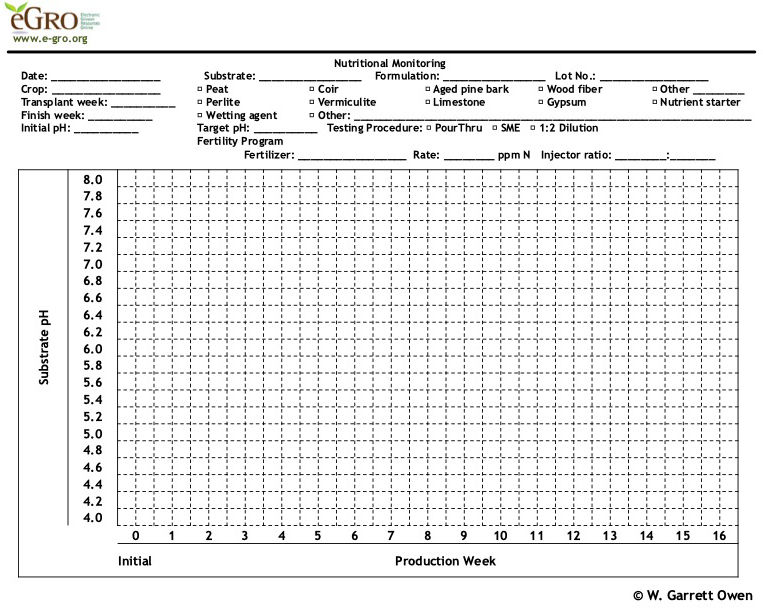Determining initial pH of greenhouse and nursery substrates
Prior to transplant, greenhouse and nursery growers can determine initial substrate pH by utilizing the 1:2 dilution procedure and establishes the baseline pH of the substrate.

Have you considered starting an in-house nutritional monitoring program and do not know where to start? There is no better time than right before or soon thereafter plugs or liners are transplanted. The 1:2 dilution monitoring procedure is a quick and simple method to determine the initial pH of your substrate. Utilizing the 1:2 dilution procedure will assist greenhouse and nursery growers in determining:
- If the limestone has reacted to adjust substrate pH.
- If the substrate pH is too low or high.
- If correction procedures are required prior to transplant.
- To establish the baseline pH of the substrate.
Before conducting a 1:2 dilution procedure, you will need the following supplies:
- Plastic 1-gallon zip-lock bag
- 3-ounce cups
- 24-ounce cups (3 cups)
- Stirring utensil
- pH/EC meter and calibration solution
- Nutritional monitoring record sheets. An example of how to record pH/EC data and plot the nutritional status of the crop overtime is provided in Table 1.

Essentially, the 1:2 dilution procedure combines (by volume) one-part pre-moistened substrate to two-parts distilled water. The procedure can be used for both greenhouse and nursery substrates and those that are pre-formulated or formulated in-house. To determine the initial substrate pH prior to planting, these steps (Fig. 1):
- Obtain a representative substrate sample of 1 gallon. The substrate sample should be free flowing, loose and decompressed. Note the lot number, substrate formulation and materials, and any amendments, e.g. limestone, gypsum, nutrient starter charge, wetting agent, slow- or controlled-release fertilizers, etc.
- In a container, moisten the substrate by adding distilled water. Note: The moisture content of the substrate should only be moist enough that when you hold the substrate in your hand and a fist is made, little to no water drips between your fingers.
- Place the moistened substrate sample in a plastic bag and seal.
- Allow the sample to sit for four days. During this time, the water will react with the limestone and the pH to adjust (raise).
- After four days, mix the substrate by gently rotating the sealed plastic bag.
- Using a 3-ounce cup (one-part by volume), extract three representative subsamples from the plastic bag. After each extraction, lightly tap the cup three times on a hard surface to allow settling. If the substrate settles below the rim of the cup, add more substrate to fill the cup to the rim. Repeat as needed until the cup is filled.
- Place each subsample into containers numbered 1 to 3 and with a volume that can hold 24 ounces or 3 cups of wet volume. Three representative subsamples are recommended to record an average.
- Add 6 ounces (two 3-ounce cups) of distilled water (two-parts by volume) to the substrate.
- Mix the sample with a stirring utensil. Once mixed, the solution will have a soupy consistency because of the excess water. Allow the sample to sit for 30 minutes.
- Calibrate the pH/EC meter. Note: Calibrate pH/EC meters before each use. Measurements are only as accurate as the last calibration. Proper pH/EC meter probe maintenance and storage should be practiced by following the manufacturer’s instructions.
- After 30 minutes, place the pH/EC meter probe into the solution. Swirl the pH/EC probe in the solution because the mixture will settle. Keep swirling the probe until the pH and/or EC stabilizes by watching the meter’s screen and record your values(s). Average the values for evaluation. Note: Rinse the pH/EC probe off with distilled water between substrate subsamples and among different substrate samples.
By following these steps, you will be able to determine the initial pH of their substrate, thus establishing the baseline pH of the substrate prior to production and an in-house nutritional monitoring program.
The American Floral Endowment is gratefully acknowledge for funding to create fertdirtandsquirt.com and establish all available materials.



 Print
Print Email
Email

